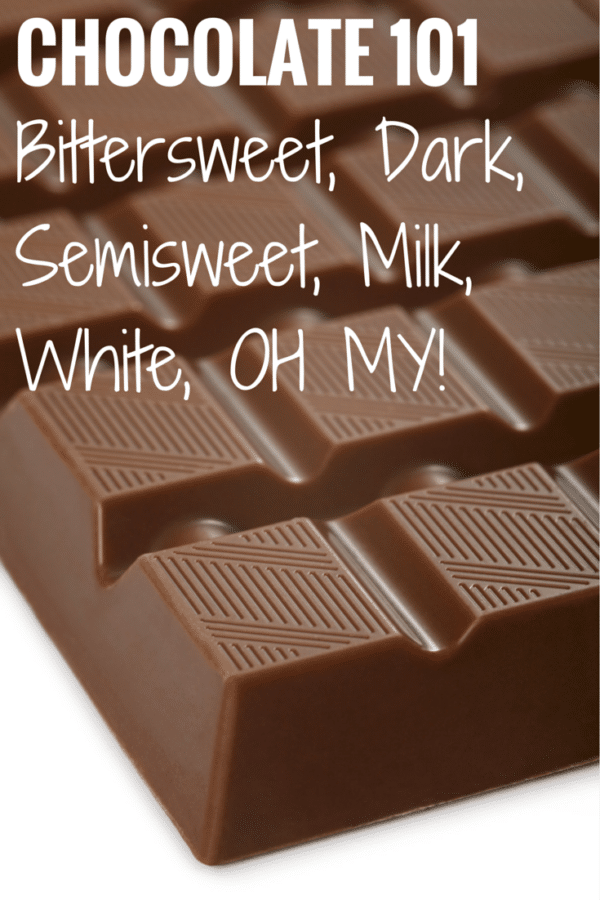Baking Basics: Chocolate 101
A thorough description of the different types of chocolate – unsweetened, bittersweet, dark, semisweet, milk and white, and when to use them!
Welcome to another installment of Baking Basics! Today we’re talking about one of my favorite ingredients – CHOCOLATE!
You’d think that chocolate would be pretty self-explanatory and when it comes to eating it, it usually is. However, when you’re baking with chocolate, there is a lot of different terminology for all of the different types of chocolate regarding how sweet it is. Knowing the difference can mean the difference between a perfect chocolatey dessert and one that is either way too bitter or way too sweet. We’re going to cover all of the bases today so you know exactly what you should be using and when.
Let’s dig in!
The 411 on Chocolate
So, how is chocolate made, anyway? Let’s start with a little science lesson to set the stage for talking about all the different types of chocolate.
Chocolate is made from cocoa beans, which are the dried and and partially fermented seeds harvested of the cacao tree. The beans are cleaned, roasted and graded, then the shell is removed to extract the nib (cacao nibs!). The nibs are then ground and liquefied, resulting in pure chocolate in liquid form, which is referred to as chocolate liquor (although no alcohol is involved). The chocolate liquor can be further processed into cocoa solids and cocoa butter. Chocolate liquor is blended with cocoa butter in varying quantities to make the different types of chocolate you see at the grocery store.
Below are the most common varieties for baking, how to tell them apart, and the brands that I use…
Unsweetened Chocolate
This chocolate is the most self-explanatory of the bunch – it is pure chocolate (solidified chocolate liquor) without any added sugar, cocoa butter, milk solids, etc. Nothing added, just chocolate. Which means that it’s extremely bitter and isn’t something that you would eat on its own, but rather add to recipes that also include sugar or some other type of sweetener.
What I Use: Scharffen Berger Unsweetened Dark Chocolate Baking Bar
Dark & Bittersweet Chocolate
When I first started baking on a regular basis, I found that many recipes called for “dark chocolate” while others called for “bittersweet chocolate”. For a novice baker, that can be downright confusing. Were they the same? Different? What should I look for at the grocery store? The short answer is that there was no set-in-stone definition, but in general, bittersweet chocolate contains at least 35% pure chocolate and has a small amount of sugar added. More often than not, however, it has a cacao percentage of more than 60%; this percentage is listed on most chocolate bars that you find in the baking aisle of your grocery store. Dark chocolate is a generic term that can mean anything from semisweet (see below) to bittersweet chocolate, but in U.S. “dark chocolate” typically refers to bittersweet chocolate above that 60% cacao threshold.
What I Use: When a recipe calls for dark or bittersweet chocolate, I use Ghirardelli 60% Cacao Baking Bar. If a recipe calls for “extra-dark” chocolate, then I will use their 70% cacao baking bar.
Semisweet Chocolate
Semisweet chocolate is straddling the fence between a sweet milk chocolate and a more bitter dark chocolate; it contains at least 35% pure chocolate with both sugar and cocoa butter added to it. This would be considered the all-purpose flour of chocolate – if you don’t like your chocolate baked goods overly sweet or too bitter, this is your go-to. It’s also the most common type of chocolate used for chocolate chips since it’s incredibly versatile and won’t overpower your recipe.
What I Use: Ghirardelli Semisweet Baking Bar
Milk Chocolate
Milk chocolate is the sweetest of chocolate products, with the distinction of not only cocoa butter and sugar added, but also milk solids. It typically contains at least 10% chocolate liquor and at least 12% milk products.
What I Use: Ghirdalli Milk Chocolate Baking Bar
White Chocolate
White chocolate is a little bit of a misnomer because it truly is not a chocolate product since it does not include chocolate liquor – it is comprised of a combination of cocoa butter, sugar, milk solids, and a flavoring like vanilla. Beware! Always read the ingredient label on white chocolate products – if it does not contain cocoa butter, then it is not actually white chocolate, but rather just a flavored baking product.
What I Use: Ghirardelli White Chocolate Baking Bar
Summing It Up
So, there you have it! All of the different types of chocolate that a baking recipe might call for, and how they’re different.
QUICK TIP! If you need to melt chocolate – whether it’s chocolate chips or chopped chocolate bars – you want to do it low and slow to prevent the chocolate from seizing up and hardening (white chocolate is particularly prone to this). I use one of two methods:
- A heatproof bowl (stainless steel is awesome!) set over a small saucepan of barely simmering water (make sure the bowl isn’t touching the water below), stirring occasionally until completely melted; or
- In the microwave on 50% power in 30-second increments, stirring after each, until the chocolate is completely melted.
BAKE ON!
Check out more posts in the Baking Basics series:
5 Mistakes to Avoid When Preparing a Recipe
Flour 101: The Definitive Guide to the Different Types of Baking Flours
Cocoa Powder 101: Natural Unsweetened vs Dutch-Process






Michelle,
When selecting chocolate for ganache, do you still use the baking bars, or do you use regular “candy” bars from the candy aisle? I typically use either Lindt or Ghirardelli 60% bar, but I’m thinking the baking bar would be cheaper…
Hi Mark, When I make ganache, I use the baking bars.
Girlfriend, I love love love all the basic post the chocolate one is icing on the cake.i have learned so much from them and they have been so helpful in my cooking thank you.
Quick Tip: “… (which chocolate is particularly prone to this.)…”
I believe that should say “white” chocolate, not “which” chocolate :)
Thanks for the information! Let me just add that when melting white chocolate, it’s trickier since it can’t come in any contact with water or oil when melting it so you can’t use any water-based or oil-based food coloring on it, just powder food coloring. I’ve learned this the hard way. I thought it melts like normal chocolate but boy it doesn’t. I encountered this when I made cake pops and my sister wanted the coating to be white chocolate.
Hi Shanelle, Thanks for sharing that! For coating things, I definitely go the candy bark route vs white chocolate – more economical for something that you’re not necessarily using for the flavor, but rather appearance.
Thanks for all these great tips. I’ll have to check out the white chocolate chips that I normally buy and see what they really are!
I LOVE your site. You feature the best recipes! I have learned so much from you! I had a couple questions regarding chocolate. Do you ever use chocolate chips? I haven’t used baking bars because I have never been able to shred or even break them into chunks easily! How do you handle baking bars? Thank you so much!!
Hi Mary, I don’t use chocolate chips for melting; only the baking bars. I use my santoku knife and just chop them up really finely if I’m melting.
Such a cute post! Chocolate means so many different things, even though most of us have just one picture in our minds when we hear the word (or see it!)
Thank you for another great post on the baking basics series.
Michelle, I have a question: When I make Buckeyes & after the chocolate hardens on the pb ball, then it dries & is hard but I typically refrigerate or freeze them. The chocolate then almost always gets white spots on it & doesn’t look dark & shiny like it did. Still tastes good but doesn’t look great! Is it bc I’m refrigerating or did I melt it too fast? I’ve tried to look this up before to see why it happens and couldn’t find a good answer. Thank you!!
That happens bc of the refrigeration/freezing.
Thank you! That’s what I wondered, but wasn’t sure if I was messing up on my melting technique.
Hi Elizabeth, Do you melt chocolate on its own or do you add something like shortening to it?
Yes, typically add coconut oil. What do you add?
Vegetable oil. I haven’t had an issue with buckeyes becoming discolored, although I’ve seen chocolates get that splotchy white color, sometimes chocolates from a store. I just assumed they were sitting for awhile?
Thanks Michelle, I live in the UK but most of the recipes I bake come from US blogs, so this round up will be something I refer to when I get a little confused : )